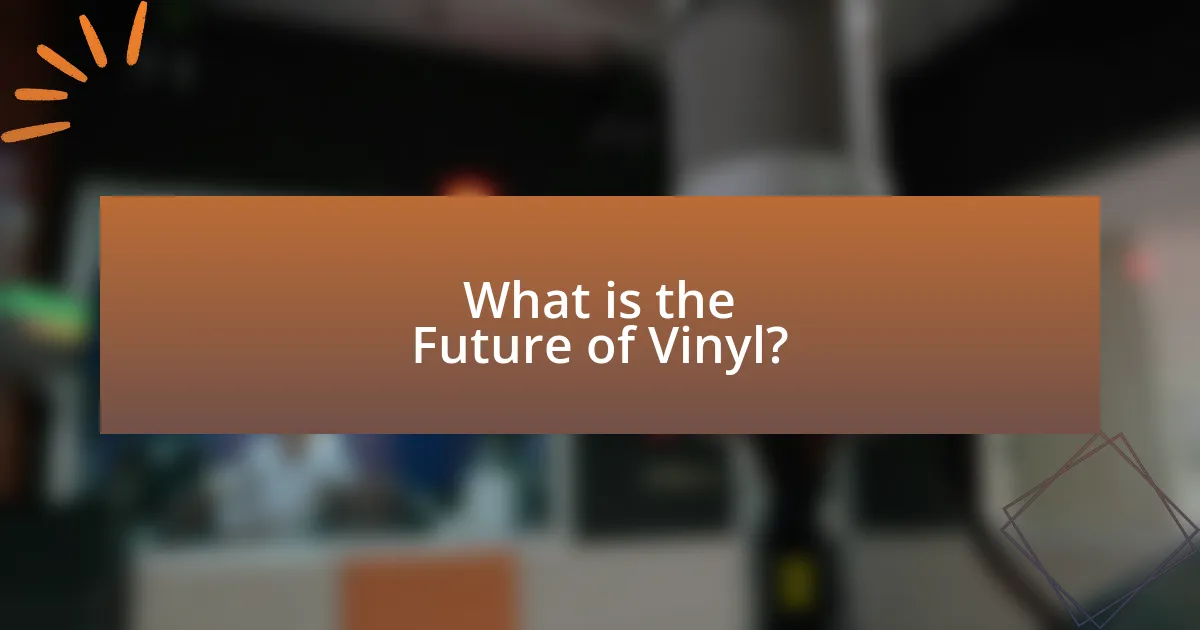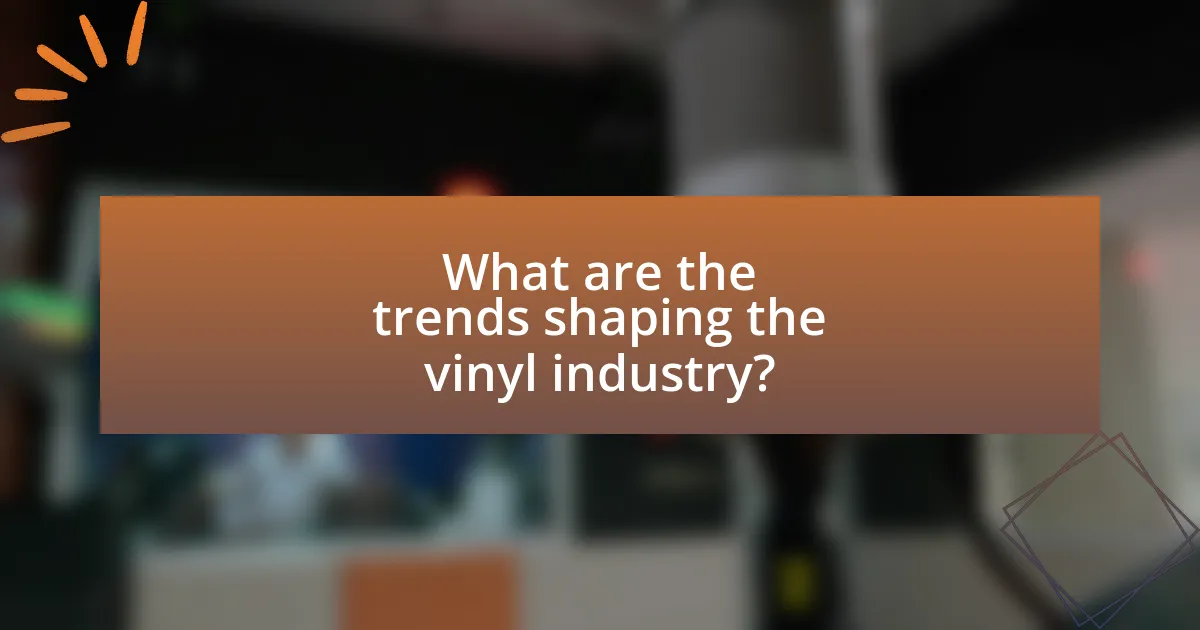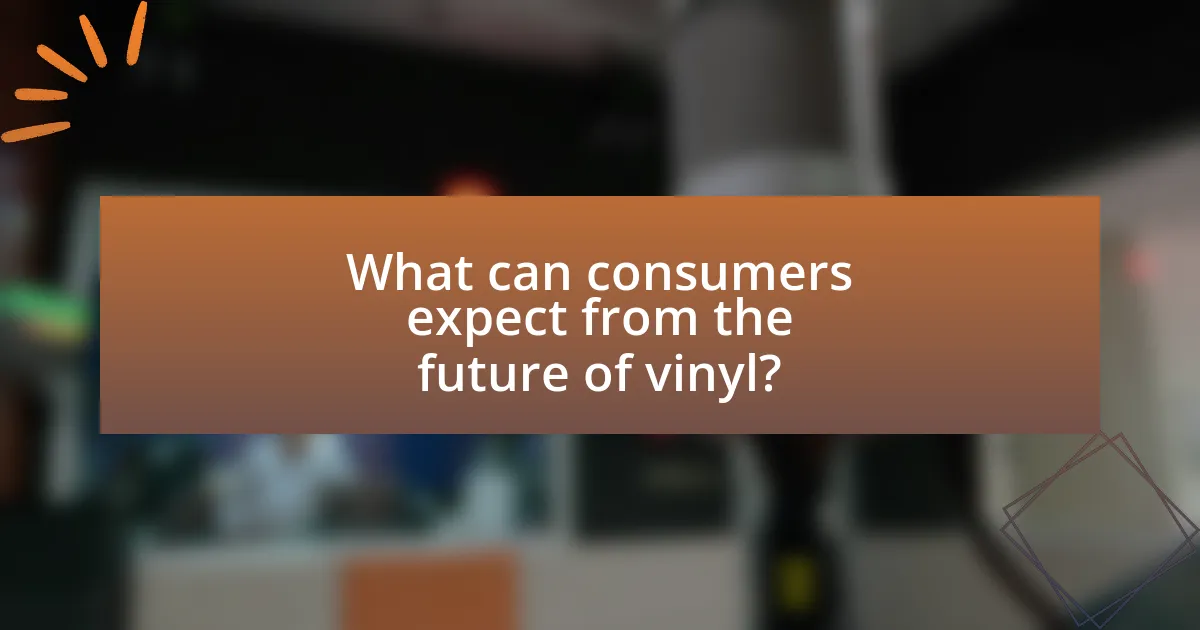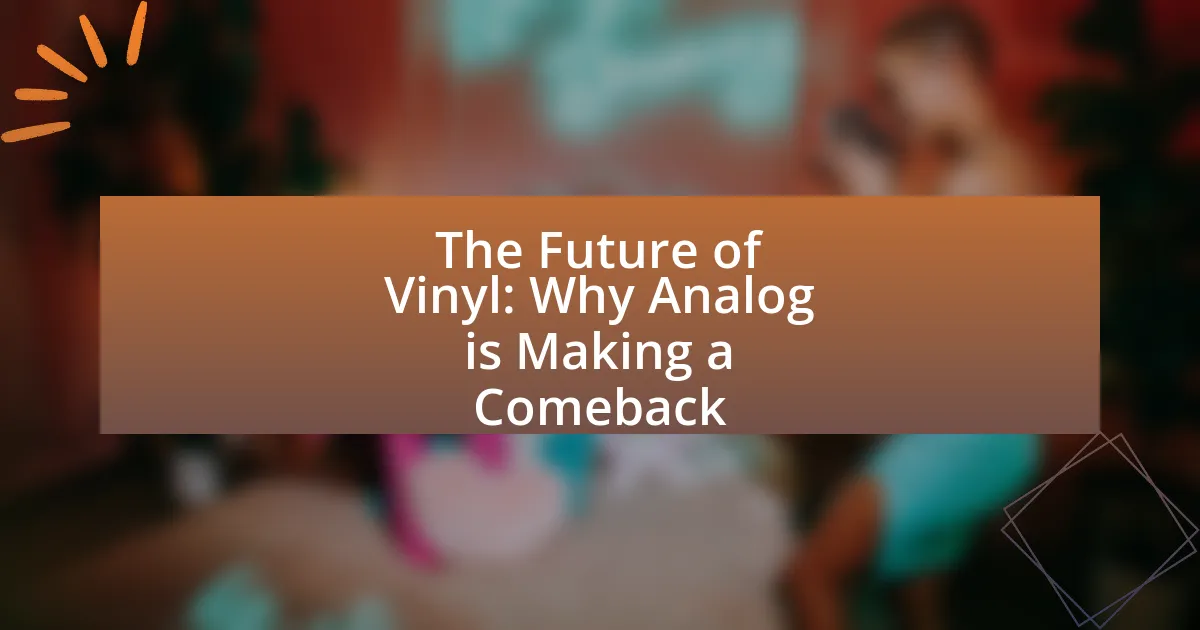The article examines the future of vinyl records, highlighting their resurgence in popularity among music enthusiasts and collectors. In 2022, vinyl sales in the United States reached 41 million units, surpassing CD sales for the first time since the 1980s. Key factors driving this revival include nostalgia, superior sound quality, and the tangible experience vinyl offers. The article also discusses the cultural influences shaping this trend, the evolving perception of vinyl, and the impact of social media and online communities on vinyl sales. Additionally, it addresses the challenges facing the vinyl industry, such as supply chain issues and environmental concerns, while outlining expectations for the future of vinyl in the music market.

What is the Future of Vinyl?
The future of vinyl is promising, as it continues to experience a resurgence in popularity among music enthusiasts and collectors. This revival is evidenced by a significant increase in vinyl sales, which reached 41 million units in the United States in 2022, marking the highest sales figures since the 1980s. The appeal of vinyl lies in its tangible nature, superior sound quality, and the nostalgic experience it offers, which contrasts with digital formats. Additionally, the growth of independent record stores and vinyl pressing plants supports this trend, ensuring a steady supply of new releases and reissues. As long as these factors remain, vinyl is likely to maintain its relevance in the music industry.
Why is vinyl experiencing a resurgence in popularity?
Vinyl is experiencing a resurgence in popularity due to a combination of nostalgia, superior sound quality, and the tangible experience it offers. The revival is evidenced by sales data; in 2022, vinyl records outsold CDs in the United States for the first time since the 1980s, with vinyl sales reaching 41 million units compared to 33 million CDs. This trend reflects a growing consumer preference for physical media and the unique aesthetic and auditory qualities that vinyl provides, appealing to both older generations and younger listeners seeking authenticity in music consumption.
What cultural factors are driving the vinyl revival?
The cultural factors driving the vinyl revival include a growing appreciation for analog sound quality, nostalgia for past music experiences, and a desire for tangible music formats. The resurgence of vinyl records is largely attributed to consumers seeking a more authentic listening experience, as studies show that many listeners perceive vinyl as offering richer sound compared to digital formats. Additionally, the emotional connection to physical records evokes nostalgia, particularly among millennials and Gen Z, who often associate vinyl with their parents’ or grandparents’ music collections. Furthermore, the rise of independent record stores and vinyl-centric events fosters community engagement and a shared cultural identity, reinforcing the vinyl trend. According to the Recording Industry Association of America, vinyl sales reached a 30-year high in 2020, indicating a significant cultural shift towards this medium.
How has the perception of vinyl changed over time?
The perception of vinyl has evolved from being viewed as an outdated medium to being celebrated as a premium format for music enthusiasts. Initially, vinyl records were largely replaced by digital formats in the late 20th century, leading to a decline in their popularity. However, since the early 2000s, there has been a significant resurgence in interest, with sales increasing dramatically; for instance, in 2020, vinyl sales in the United States surpassed CD sales for the first time since the 1980s, according to the Recording Industry Association of America. This shift reflects a growing appreciation for the tactile experience and sound quality associated with vinyl, as well as a cultural trend towards nostalgia and analog authenticity in music consumption.
What role does nostalgia play in the vinyl comeback?
Nostalgia plays a significant role in the vinyl comeback by driving consumer interest and emotional connection to music. Many individuals who grew up in the era of vinyl associate it with cherished memories and experiences, leading to a resurgence in demand for physical records. According to a report by the Recording Industry Association of America (RIAA), vinyl sales reached a 30-year high in 2020, indicating that consumers are increasingly seeking the tactile and auditory experience that vinyl provides, which is often linked to nostalgia for past musical eras. This emotional attachment not only influences purchasing decisions but also fosters a sense of community among collectors and enthusiasts, further solidifying vinyl’s place in contemporary music culture.
How does nostalgia influence consumer behavior towards vinyl?
Nostalgia significantly influences consumer behavior towards vinyl by evoking emotional connections to past experiences and cultural moments. This emotional resonance drives consumers to seek out vinyl records as a means of reliving cherished memories associated with music from their youth. Research indicates that nostalgia can enhance the perceived value of products; for instance, a study published in the Journal of Consumer Research found that nostalgic feelings can increase consumers’ willingness to pay for items that remind them of their past. Consequently, the resurgence of vinyl is largely fueled by consumers’ desire to reconnect with the tactile and auditory experiences of earlier music formats, reinforcing the trend of vinyl’s comeback in the digital age.
What generations are most drawn to vinyl records?
Millennials and Generation Z are the generations most drawn to vinyl records. According to a 2021 report by the Recording Industry Association of America (RIAA), vinyl sales have surged, with younger consumers driving this trend; 18-29-year-olds accounted for 50% of vinyl sales. This resurgence is attributed to the tactile experience and nostalgia associated with vinyl, appealing to younger audiences who seek authenticity in music consumption.
How does the sound quality of vinyl compare to digital formats?
Vinyl sound quality is often perceived as warmer and more natural compared to digital formats, which can sound cleaner but sometimes less dynamic. This difference arises because vinyl captures a continuous waveform, allowing for a richer harmonic content, while digital formats typically sample sound at discrete intervals, potentially losing some nuances. Studies have shown that many listeners prefer the analog warmth of vinyl, attributing it to the presence of subtle distortions and the absence of compression often found in digital recordings.
What are the technical aspects of vinyl sound quality?
The technical aspects of vinyl sound quality include factors such as frequency response, dynamic range, and surface noise. Vinyl records can reproduce a wide frequency range, typically from 20 Hz to 20 kHz, which aligns with human hearing capabilities. The dynamic range of vinyl is generally around 70 dB, allowing for a significant contrast between the quietest and loudest sounds. Additionally, surface noise, which arises from imperfections in the vinyl and dust, can affect overall sound quality, but high-quality pressings and proper maintenance can minimize this issue. These characteristics contribute to the unique warmth and depth often associated with vinyl sound, distinguishing it from digital formats.
How do audiophiles perceive the differences between vinyl and digital?
Audiophiles perceive vinyl as offering a warmer, richer sound compared to digital formats, which they often describe as more sterile or clinical. This perception stems from the analog nature of vinyl, which captures sound waves in a continuous form, allowing for a more nuanced representation of audio. In contrast, digital formats use sampling, which can lead to a loss of certain audio details, particularly in the higher frequencies. Studies, such as those conducted by the Audio Engineering Society, have shown that many listeners prefer the sound of vinyl due to its harmonic distortion characteristics, which can enhance the listening experience. Additionally, the tactile and physical aspects of vinyl, including album artwork and the act of playing a record, contribute to a more immersive experience that audiophiles value.

What are the trends shaping the vinyl industry?
The trends shaping the vinyl industry include a resurgence in consumer interest, increased production capacity, and the rise of niche markets. Consumer interest in vinyl records has grown significantly, with sales reaching 41 million units in 2022, marking the highest level since the 1980s, according to the Recording Industry Association of America. Increased production capacity is evident as manufacturers invest in new pressing plants to meet demand, with over 30 new facilities opening in the last few years. Additionally, niche markets are emerging, focusing on specific genres, limited editions, and collaborations with artists, further driving the vinyl revival.
How are record labels adapting to the vinyl resurgence?
Record labels are adapting to the vinyl resurgence by increasing their production of vinyl records and expanding their catalog offerings. In response to the growing consumer demand, which saw vinyl sales surpass CD sales in the U.S. for the first time since the 1980s, labels are investing in new pressing plants and enhancing their distribution networks. For instance, in 2021, vinyl sales reached 38 million units, reflecting a 61% increase from the previous year, prompting labels to prioritize vinyl releases alongside digital formats. Additionally, many labels are collaborating with artists to create exclusive vinyl editions, often featuring unique artwork and limited runs, which cater to collectors and enthusiasts. This strategic shift not only capitalizes on the nostalgia associated with vinyl but also aligns with the trend of consumers seeking tangible music experiences.
What strategies are labels using to promote vinyl releases?
Labels are employing various strategies to promote vinyl releases, including limited edition pressings, exclusive artwork, and targeted marketing campaigns. Limited edition pressings create a sense of urgency and exclusivity, appealing to collectors and enthusiasts. Exclusive artwork often features unique designs or packaging that enhance the aesthetic value of the vinyl, making it more desirable. Additionally, targeted marketing campaigns leverage social media platforms and influencer partnerships to reach niche audiences, effectively increasing visibility and engagement. These strategies are supported by the resurgence of vinyl sales, which reached 41 million units in the U.S. in 2022, indicating a strong consumer interest in physical formats.
How has the production process for vinyl changed recently?
The production process for vinyl has recently evolved to incorporate advanced technology and sustainable practices. Modern vinyl manufacturing now utilizes digital cutting techniques, which enhance precision and reduce waste compared to traditional methods. Additionally, there has been a significant shift towards eco-friendly materials, such as recycled PVC and plant-based alternatives, reflecting a growing awareness of environmental impact. According to the Vinyl Industry Report 2023, these innovations have led to a 20% increase in production efficiency while minimizing carbon footprints, demonstrating a clear trend towards modernization in the vinyl production landscape.
What impact does social media have on vinyl sales?
Social media significantly boosts vinyl sales by enhancing visibility and engagement among music enthusiasts. Platforms like Instagram and TikTok allow artists and labels to showcase vinyl releases, creating buzz and driving consumer interest. For instance, a report from the Recording Industry Association of America (RIAA) indicated that vinyl sales reached 27.5 million units in 2021, largely attributed to social media marketing strategies that connect directly with younger audiences. This trend illustrates how social media acts as a catalyst for the resurgence of vinyl, making it a popular choice for collectors and casual listeners alike.
How are influencers and platforms promoting vinyl culture?
Influencers and platforms are promoting vinyl culture by leveraging social media to showcase vinyl collections, share music recommendations, and create engaging content around the tactile experience of vinyl. For instance, platforms like Instagram and TikTok feature influencers who post videos of unboxing new records, discussing album artwork, and highlighting the nostalgia associated with vinyl, which resonates with both new listeners and seasoned collectors. This trend is supported by data showing that vinyl sales reached 41 million units in 2020, the highest level since the 1980s, indicating a significant resurgence in interest driven by these digital platforms and influencers.
What role do online communities play in the vinyl market?
Online communities significantly influence the vinyl market by fostering connections among enthusiasts, facilitating the exchange of information, and driving sales through collective engagement. These platforms, such as forums and social media groups, allow users to share recommendations, discuss new releases, and trade records, which enhances the overall vinyl culture. According to a 2021 report by the Recording Industry Association of America, vinyl sales reached a 30-year high, partly attributed to the active participation of online communities that promote vinyl appreciation and accessibility.
What are the challenges facing the vinyl industry today?
The vinyl industry today faces several significant challenges, including supply chain disruptions, rising production costs, and competition from digital formats. Supply chain disruptions have been exacerbated by the COVID-19 pandemic, leading to delays in the availability of raw materials such as PVC, which is essential for vinyl record production. Rising production costs, driven by increased prices for materials and labor, have made it difficult for manufacturers to maintain profitability while keeping prices accessible for consumers. Additionally, competition from digital music platforms continues to pose a threat, as many consumers prefer the convenience and affordability of streaming services over physical media. These factors collectively hinder the growth and sustainability of the vinyl industry in the current market landscape.
How does the supply chain affect vinyl production?
The supply chain significantly affects vinyl production by influencing the availability and cost of raw materials, manufacturing processes, and distribution logistics. For instance, the production of vinyl records requires specific materials such as PVC, which can be subject to fluctuations in supply due to global market conditions or disruptions like natural disasters. Additionally, the manufacturing process relies on specialized machinery and skilled labor, both of which can be impacted by supply chain inefficiencies. According to a report by the Recording Industry Association of America, the resurgence in vinyl popularity has led to increased demand, which can strain existing supply chains and result in longer lead times for production. This interplay between supply chain dynamics and vinyl production ultimately shapes the industry’s ability to meet consumer demand effectively.
What environmental concerns are associated with vinyl manufacturing?
Vinyl manufacturing is associated with several environmental concerns, primarily due to the production process and the materials used. The production of polyvinyl chloride (PVC), a key component in vinyl, involves the release of harmful chemicals such as dioxins and phthalates, which can contaminate air and water sources. Additionally, the extraction of fossil fuels for vinyl production contributes to greenhouse gas emissions, exacerbating climate change. According to the U.S. Environmental Protection Agency, PVC production is linked to significant environmental pollution, including toxic waste generation. Furthermore, the disposal of vinyl products poses challenges, as they are not biodegradable and can persist in landfills for hundreds of years, leading to long-term environmental degradation.

What can consumers expect from the future of vinyl?
Consumers can expect continued growth in the vinyl market, driven by a resurgence in interest for analog music formats. According to the Recording Industry Association of America (RIAA), vinyl sales reached a 30-year high in 2020, surpassing CD sales for the first time since the 1980s. This trend indicates a strong consumer preference for the tactile experience and sound quality associated with vinyl records. Additionally, the expansion of vinyl pressing plants and increased availability of new releases on vinyl suggest that the format will remain a significant part of the music industry, catering to both collectors and new listeners alike.
How will technology influence the vinyl experience?
Technology will enhance the vinyl experience by improving sound quality, accessibility, and user engagement. Innovations such as high-fidelity digital mastering techniques allow for better audio reproduction, making vinyl records sound clearer and more dynamic. Additionally, advancements in turntable design, including features like Bluetooth connectivity and built-in speakers, make it easier for consumers to enjoy vinyl without needing extensive audio setups. Furthermore, digital platforms that offer vinyl subscription services or curated playlists increase accessibility, allowing users to discover and purchase records more conveniently. These technological influences are supported by the resurgence of vinyl sales, which reached 41 million units in the U.S. in 2022, indicating a growing consumer interest in both analog and digital formats.
What innovations are being introduced in vinyl record production?
Innovations in vinyl record production include advancements in materials, such as the use of high-quality PVC and eco-friendly alternatives, which enhance sound quality and reduce environmental impact. Additionally, modern cutting techniques, like laser engraving, allow for more precise grooves, resulting in improved audio fidelity. The integration of digital technology in the mastering process also enables better sound optimization, ensuring that vinyl records meet contemporary audio standards. These innovations are supported by the resurgence of vinyl sales, which reached 41 million units in the U.S. in 2022, indicating a strong market demand for high-quality analog products.
How might streaming services integrate with vinyl sales?
Streaming services might integrate with vinyl sales by offering exclusive vinyl editions of albums that are also available for streaming. This integration can enhance the consumer experience by providing a tangible product alongside digital access, appealing to both audiophiles and casual listeners. For instance, services like Spotify and Apple Music could partner with vinyl manufacturers to create limited edition releases that include unique artwork or bonus tracks, incentivizing purchases. Additionally, data from the Recording Industry Association of America (RIAA) indicates that vinyl sales have seen a resurgence, with revenue reaching over $1 billion in 2022, highlighting a growing market that streaming services can capitalize on by bridging the gap between digital and physical formats.
What are the best practices for starting a vinyl collection?
To start a vinyl collection effectively, focus on selecting a specific genre or artist that resonates with you. This targeted approach helps in building a cohesive collection and enhances your enjoyment of the music. Begin by researching reputable record stores or online platforms that specialize in vinyl, as they often provide a wide selection and knowledgeable staff. Additionally, consider investing in a quality turntable and speakers to ensure optimal sound quality, as the listening experience is crucial in appreciating vinyl records. According to the Recording Industry Association of America, vinyl sales have seen a significant resurgence, indicating a growing interest in analog formats, which further supports the value of starting a collection.
How can collectors identify quality vinyl records?
Collectors can identify quality vinyl records by examining the condition of the record, the label, and the pressing details. A high-quality vinyl record will typically have a glossy surface free from scratches, warps, or dust, which can affect playback. Additionally, collectors should look for records that are pressed on heavyweight vinyl, as these tend to produce better sound quality and durability.
The label can provide insights into the record’s authenticity and pressing history; original pressings from reputable labels often indicate higher quality. Furthermore, collectors should consider the matrix numbers etched into the run-out groove, as these can reveal the specific pressing and its lineage. For example, first pressings are generally more sought after and can indicate superior sound quality compared to later reissues.
Research indicates that records pressed on 180-gram vinyl are often associated with higher fidelity and less surface noise, making them a preferred choice among audiophiles. Collectors can also utilize resources like Discogs or the Vinyl Factory to verify pressing details and historical context, ensuring they make informed purchasing decisions.
What tips can help new collectors navigate the vinyl market?
New collectors can navigate the vinyl market effectively by researching artists and albums before purchasing. Understanding the history and value of specific records helps collectors make informed decisions. For instance, knowing that first pressings of popular albums often hold higher value can guide purchasing choices. Additionally, visiting local record stores and attending vinyl fairs allows collectors to interact with knowledgeable sellers and discover unique finds. Engaging with online communities and forums dedicated to vinyl collecting can also provide valuable insights and tips from experienced collectors.
